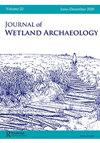Jortveit农场湿地:挪威斯卡格拉克海岸的新石器时代渔场
Q1 Arts and Humanities
引用次数: 3
摘要
摘要1931年,在挪威南部Jortweit农场的湿地上发现了几件骨骼和石器时代的人工制品,以及鱼类和鲸须。2018-19年,在原始发现地点进行了小规模挖掘,并制作了一系列AMS日期。挖掘发现了具有特殊保存条件的泥浆剖面。至125–130 深度为厘米的淤泥中有未燃烧的鱼和鲸鱼骨头、烧焦的木棍和石器时代的手工艺品。AMS在挖掘过程中发现的零散发现物和样本的日期大约在公元前3700年至2500年之间,即斯堪的纳维亚新石器时代早期和中期。几乎所有的骨头都属于大西洋蓝鳍金枪鱼。将结果与当地的气候和景观重建进行了比较,并讨论了新石器时代的海洋适应问题。我们发现,Jortveit遗址代表了新石器时代专门适应海洋的景观。本文章由计算机程序翻译,如有差异,请以英文原文为准。
The Jortveit farm wetland: A Neolithic fishing site on the Skagerrak coast, Norway
ABSTRACT In 1931, several osseous and lithic artefacts, as well as fish and whalebones, were discovered in the wetland at the Jortveit farm in Southern Norway. In 2018–19, a small-scale excavation at the original find location took place and a series of AMS-dates were produced. The excavation identified a mud profile with exceptional preservation conditions. At ∼125–130 cm depth, the mud contained unburnt fish and whale bones, burnt wooden sticks and lithic artefacts. AMS-dates of stray finds and samples retrieved during the excavation date to the period roughly between 3700–2500 cal BCE, i.e. Scandinavian Early and Middle Neolithic Periods. Nearly all bones belong to the Atlantic bluefin tuna (Thunnus thynnus). The results are compared to local climate and landscape reconstructions, and the question of marine adaptation in the Neolithic is discussed. We find that the Jortveit site represented a patch in the landscape for specialized marine adaptation in the Neolithic.
求助全文
通过发布文献求助,成功后即可免费获取论文全文。
去求助
来源期刊

Journal of Wetland Archaeology
Arts and Humanities-Archeology (arts and humanities)
CiteScore
1.40
自引率
0.00%
发文量
6
期刊介绍:
The Journal of Wetland Archaeology publishes a wide range of contributions in all fields of wetland archaeology. It includes scientific and methodological features, geoprospection, environmental reconstruction, wetland hydrology, cultural aspects of wetland archaeology, as well as conservation, site management, legislation, and site protection. All periods and all geographic regions are covered.
 求助内容:
求助内容: 应助结果提醒方式:
应助结果提醒方式:


